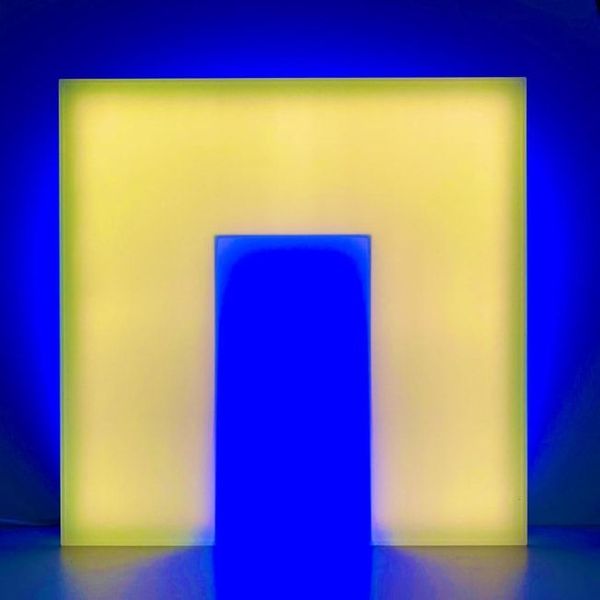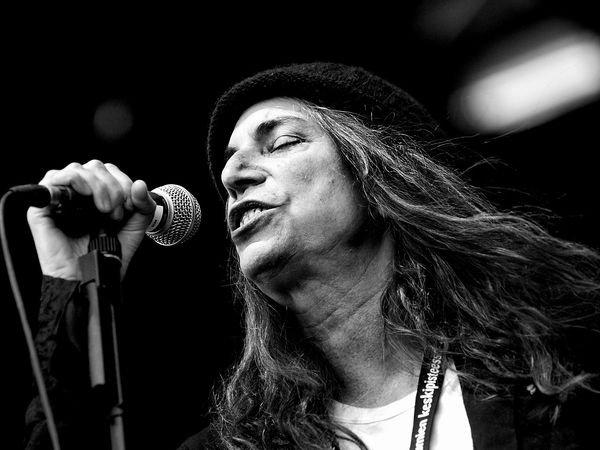by Rapha Grumser
In the front window of Paul Stolper’s Gallery—a stone’s throw from the British Museum in Bloomsbury—is a boxy television monitor from the 1980s laid on its side, from which slow-moving images of a cityscape wheeze forth in oneiric VHS grain. On display is Brian Eno’s Mistaken Memories of Mediaeval Manhattan, whose sideways, low-fidelity capture of New York City skylines renders the material surreal, making mist out of brick and cloud. Pensive, static shots of lower Manhattan’s rooftops at golden hour give the impression of buildings suspended in amber. I think of Calvino’s cities, like dreams, “made of desires and fears, even if the thread of their discourse is secret, their rules absurd, their perspectives deceitful, and everything conceals something else.”
I am five minutes late to my scheduled meeting with Stolper, whose gallery is currently showing The Surrenderer, an exhibition featuring five of Eno’s recent LED light-boxes and a ceramic vase with two metal flowers that project sound instead of scent. I am greeted at the door of the rectangular gallery by Paul, who is attending to a man in an overcoat—a potential client, it seems. “Can we push the meeting back a half-hour?” he asks.
As Paul and the overcoated man exit, I become aware of the sounds in the room: the front door closing and Paul’s chatter receding into the street, the ponytailed gallery assistant’s typing punctuated by the sound of sniffles, a diaphanous texture emanating softly from the back of the room. I float to the end of the exhibit, past the ponytailed assistant, past the right-hand protrusion which both displays the light-box Umbria III and obscures part of the room. I follow the sound to its source: the large ceramic vase whose two metal flowers are actually speakers. Its name is Malva. It greets me with an ethereal recording composed of processed, slow-ringing bell tones atop a layer of sound design that reminds me of David Tudor’s Rainforest.
The walls adjacent to Malva form an open box with the side-protrusion, creating a nook that is obscured from the front of the gallery. The light-boxes Umbria I and Umbria II are housed in this nook, outside the ponytailed assistant’s visual purview, where they reflect diffuse, colored light into the space. I sit down cross-legged, alone on a floor of hardwood planks painted dolphin grey; they take on the now-yellowish hues of the LED Umbrias above. As I take inventory of myself, the light-boxes begin their indolent shift from yellow to blue.
Brian Eno was wearing a monochrome outfit of royal blue and eating a poke bowl last Thursday when I first walked into Stolper’s gallery. I had spent the day going around to different shows with my friend Rafael. We saw one called Triggered Economics, housed in a repurposed office space that a hedge fund had abandoned at the beginning of the pandemic. We saw Bob Dylan’s paintings at the Halcyon in Mayfair. We ate a soup lunch at the London Review Bookshop, and I purchased a copy of Rilke’s Letters To A Young Poet. Then we parted ways. I walked east. 10 minutes later, Rafael called, telling me to come back to where we left: “I just stumbled upon something great. You won’t regret it.”
I walked back to Museum Street, perplexed, until I saw Rafael speaking to two seated men inside a gallery that had a boxy TV laid on its side and a printed text that said Brian Eno: The Surrenderer. From outside the window I saw Rafael wave his arm wildly. I walked inside and the three men looked at me. The man seated closest to the window looked up from his poke and introduced himself as Brian. The afternoon light danced in rings around the splendid bald dome of his head. “Another Raphael!” he exclaimed when I introduced myself.
I was speechless as I listened to the three older men talk. Brian told a story about his friend and former teacher, artist Tom Phillips, who had traced his student-teacher lineage back through Auerbach, Bomberg, Sickert, all the way to Raphael (the Renaissance one, the only Raphael aside from the biblical archangel who can lay claim to the monomer). Phillps’ artistic genealogical tree was originally devised as a television project whose title would have been Raphael to Eno. Paul Stolper gave us each a copy of Light Music, an art book from Eno’s 2016 exhibition. I nervously pushed the open book towards Brian and asked him to sign it. “We’ve heard of ‘From Raphael to Eno,’” he said with a coy smile as he put silver pen to the deep blue paper on the inside cover, “now here’s ‘From Eno to Raphael.’”
My legs have fallen asleep against the hardwood floor; I hear the sound of fabric on wood as I uncross them. The ponytailed assistant types, sniffles, resumes typing. I am waiting for Paul. Umbria II is changing from deep blue to orange overhead. I think of Arto Lindsay’s “4 Skies”: “One sky is orange / Some skies are grey / Or a deep dark blue / That gave blue its name.” I think of the procession of VHS skylines on the sideways monitor at the front of the gallery. Eno filmed those in 1980-1981.
In 1978, just before making Mistaken Memories, Brian Eno produced No New York, a compilation of no wave bands he discovered after arriving in Manhattan. On this subject, Eno has compared himself to Alan Lomax, taking on the role of ethnomusicologist and documenting an ephemeral scene as it happened in the village of downtown New York in the late ’70s. Lindsay, of DNA fame, recalled the recording sessions thus: “He set us up in the studio and we started to play and he was sitting there reading a magazine. I was furious and started screaming at him, ‘This is our life, this is our music!’ I think he appreciated it.”
Years later, on a return visit to New York, Eno would write in A Year with Swollen Appendices, his 1995 diary, “[It] suddenly occurred to me last night that Arto may be someone to whom I could address my writing. I think he’d get it, and I don’t care much whether he actually responds or not.” Entries in the diary make reference to studio visits during Arto’s production of his debut solo record, O Corpo Sutil (The Subtle Body), on which the track “4 Skies” appears. “I need a way / to say ‘you’re scorching,’” Arto sings as Eno’s saturated sonics sound off in the reverby distance. “A seething, crumpled, teeming sky.”
“Years later,” Brian Eno writes in Light Music, “I asked Arto Lindsay why he thought people wanted to make Art. He said ‘it’s the closest we get to magic.’”
Malva has briefly gone silent. The first ambient piece that played from her metal flowers has stopped flowing. With a soft pause in the space of a breath, she begins sounding off a new one—one that begins with an A minor triad in the voice of an organ. Light, metallic splashes of chimes or bells effected with delays sound out over the bed of the organ drone; the drone is an anchor. I feel my legs firmly rooted in the hardwood planks. I hear myself breathing. Further away, the ponytailed assistant is typing, sniffles, and continues. I am waiting for Paul. The Umbrias above are now different shades of green. I notice that my mood has changed, that I am now in a different mental space, as if waking up in another section of the same dream.
I wonder what I will ask Paul in our interview when he returns. In truth, I am hoping he will connect me with Brian (ostensibly for a magazine interview). But even in the unlikely scenario that I was connected with Brian through force of inelegant will, I do not know what I would ask him. I would likely have no more words than when I met him by pure chance last week and was struck by his friendliness as the afternoon light ring-danced around his bald head like a halo.
I was giddy all last week after the fortuitous encounter with Brian, but I do not exactly know why. I jumped down a vast internet rabbit-hole, looking for ways to connect myself to Brian. I looked at Tom Phillips’ website. If Eno took me on as his student, I would be the 22nd in a line of students, all the way back to Raphael. From Raphael to Raphael—I found the arrogance and base narcissism of this thought amusing. It was hideous, in a way, and I was ashamed of it; but then I wondered why this impulse to connect oneself to something larger should be so vile.
I discovered Phillips’ After Raphael. The 1973 work is a geometric abstraction of Umbrian School, c. 1490-1500. Votive Picture, which Phillips happened upon while judging a competition. This picture had been attributed to a young Raphael. Subsequently, Eno used a section of After Raphael as the cover artwork for his 1975 album, Another Green World.
Raphael. Raphael. Raphael.
Waves of color and sound wash over me. (Have I forgotten why I came here in the first place?)
I have been sitting still, very still, like when, as a teenager, I would paddle out on my surfboard in the late afternoon, past the waves to the flatwater. I would sit on the board and watch the sunset’s orange and red and purple hues reflected on the smooth, cold water around me. Then I would back-paddle to the break, and sit, and wait. And when the wave came I paddled hard, pushing my arms and legs to the brink of their control until, after a few moments, I would feel myself being carried away. I would stand up and surrender to the water, maneuvering slightly to let the curl carry me back to the sand.
I hear the door at the front gallery opening and Paul returning. He walks to the back of the gallery and finds me on the floor in front of Umbria II. “Why didn’t you ask for a chair?” he wonders.
I look up at him, then turn back to Umbria II. Paul turns to admire it as well: “It really teaches you patience, doesn’t it?”
“Umbria II” by Brian Eno, 2020 (Light box: LED lights, perspex, wood)
Rapha Grumser co-edits Laid Off NYC's Music section. Get to know him better: @raphagrumser
Thumbnail image: “Amunet” by Brian Eno, 2020 (Light box: LED lights, Acrylic, resin)



